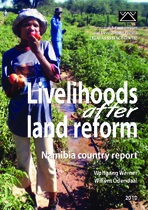| dc.contributor.author | Werner, Wolfgang | |
| dc.contributor.author | Odendaal, Willem | |
| dc.date.accessioned | 2019-03-14T08:35:25Z | |
| dc.date.available | 2019-03-14T08:35:25Z | |
| dc.date.issued | 2010 | |
| dc.identifier.citation | Werner, W. et al. (2010). Livelihoods after land reform. Report. Institute for Poverty, Land and Agrarian Studies, University of the Western Cape | en_US |
| dc.identifier.uri | http://hdl.handle.net/10566/4510 | |
| dc.description.abstract | In 1990, Namibia emerged from colonial rule with a skewed distribution of agricultural
land and high levels of poverty. The new government led by SWAPO Party initiated a
process to address the land question within the first few months of Independence. A
National Conference on Land Reform and the Land Question in 1991 was the foundation on
which the Namibian government developed its land reform programme. The Ministry of
Lands, Resettlement and Rehabilitation started in 1990 to acquire freehold farmland for
subdivision and allocation to previously disadvantaged Namibians. This component of
redistributive land reform was complemented by the Affirmative Action Loan Scheme (AALS)
established in 1992. The AALS provided subsidised loans to previously disadvantaged
Namibians to acquire large-scale commercial farms under freehold title.
The primary objectives of land reform in Namibia were to address injustices which largescale
land dispossession had brought about, and to reduce poverty and inequality. However,
little empirical work has been done to assess the impact of land redistribution on poverty
levels and the livelihoods of beneficiaries. The most comprehensive survey on the impact of
land redistribution was conducted by the Permanent Technical Team on Land Reform (PTT)
in 2003/04. The primary objective of this survey on “livelihoods after land reform” is to add
to the existing body of knowledge on land redistribution.
Through case studies in Hardap and Omaheke Regions, the survey explored the extent to
which land redistribution is reducing poverty and meeting livelihood improvement objectives. | en_US |
| dc.language.iso | en | en_US |
| dc.publisher | Institute for Poverty, Land and Agrarian Studies, University of the Western Cape | en_US |
| dc.relation.ispartofseries | Report; | |
| dc.subject | Livelihoods | en_US |
| dc.subject | Land reform | en_US |
| dc.subject | Namibia | en_US |
| dc.subject | Agricultural land | en_US |
| dc.subject | Commercial farms | en_US |
| dc.title | Livelihoods after land reform | en_US |
| dc.type | Other | en_US |

